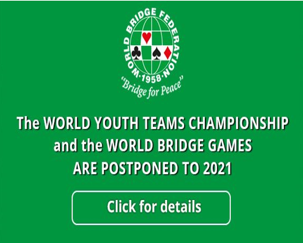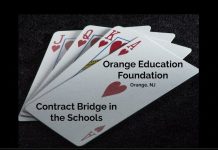Pass, despite your 21 high-card points. Partner can’t have much. The other three players have a total of 19 HCP, and East did open. At this vulnerability, any time partner is short in hearts, he will be eager to sacrifice by bidding 4

over 4

.
Situation 3: When you are a passed hand, slam is very unlikely. The only two exceptions are when partner opens 2

, and when partner opens one of a suit, you find at least a nine-card fit and at least one of you
has excellent distribution.
For example, you pass in first or second seat holding:

KJ3

KQJ

Q54

7543. Partner opens 2NT.
Bid 3NT. You correctly passed originally because your hand was extremely unattractive. Once you subtract for 4-3-3-3 distribution and too many quacks (queens and jacks), this mess is not worth 12 HCP. If partner had opened 2

and rebid 2NT, then you would have been interested.
Situation 4: When partner opens and you respond 1NT, slam is rare unless opener jump shifts and you have a nice fit in his second suit. This is true whether or not the 1NT bid is forcing. The auction proceeds 1

-1NT (forcing); 3

and your hand is:

6

A87

KQ9

Q87532
Bid 3NT. Obviously, you could have had much less for your forcing 1NT response, but without a fit, you should be content to play in game.
Situation 5: When responder makes a limit raise, opener should consider slam only when he has both a terrific hand and a singleton or void. You open 1

and partner bids 3

showing a limit raise with four-card support.
Holding:

KQJ986

AQ

QJ4

K3, bid 4

. Slam is very unlikely. You have only one ace, and the majority of your honor cards are quacks.
 over 4
over 4 .
Situation 3: When you are a passed hand, slam is very unlikely. The only two exceptions are when partner opens 2
.
Situation 3: When you are a passed hand, slam is very unlikely. The only two exceptions are when partner opens 2 , and when partner opens one of a suit, you find at least a nine-card fit and at least one of you
has excellent distribution.
For example, you pass in first or second seat holding:
, and when partner opens one of a suit, you find at least a nine-card fit and at least one of you
has excellent distribution.
For example, you pass in first or second seat holding:  KJ3
KJ3  KQJ
KQJ  Q54
Q54  7543. Partner opens 2NT.
Bid 3NT. You correctly passed originally because your hand was extremely unattractive. Once you subtract for 4-3-3-3 distribution and too many quacks (queens and jacks), this mess is not worth 12 HCP. If partner had opened 2
7543. Partner opens 2NT.
Bid 3NT. You correctly passed originally because your hand was extremely unattractive. Once you subtract for 4-3-3-3 distribution and too many quacks (queens and jacks), this mess is not worth 12 HCP. If partner had opened 2 and rebid 2NT, then you would have been interested.
Situation 4: When partner opens and you respond 1NT, slam is rare unless opener jump shifts and you have a nice fit in his second suit. This is true whether or not the 1NT bid is forcing. The auction proceeds 1
and rebid 2NT, then you would have been interested.
Situation 4: When partner opens and you respond 1NT, slam is rare unless opener jump shifts and you have a nice fit in his second suit. This is true whether or not the 1NT bid is forcing. The auction proceeds 1 -1NT (forcing); 3
-1NT (forcing); 3 and your hand is:
and your hand is:  6
6  A87
A87  KQ9
KQ9  Q87532
Bid 3NT. Obviously, you could have had much less for your forcing 1NT response, but without a fit, you should be content to play in game.
Situation 5: When responder makes a limit raise, opener should consider slam only when he has both a terrific hand and a singleton or void. You open 1
Q87532
Bid 3NT. Obviously, you could have had much less for your forcing 1NT response, but without a fit, you should be content to play in game.
Situation 5: When responder makes a limit raise, opener should consider slam only when he has both a terrific hand and a singleton or void. You open 1 and partner bids 3
and partner bids 3 showing a limit raise with four-card support.
Holding:
showing a limit raise with four-card support.
Holding:  KQJ986
KQJ986  AQ
AQ  QJ4
QJ4  K3, bid 4
K3, bid 4 . Slam is very unlikely. You have only one ace, and the majority of your honor cards are quacks.
. Slam is very unlikely. You have only one ace, and the majority of your honor cards are quacks.

























